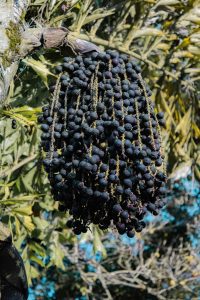
What are Goji Berries?
Goji berries, scientifically known as Lycium barbarum, are small, red berries that have been a staple in traditional Chinese medicine for centuries. Also referred to as wolfberries, these fruits are native to Asia but are now cultivated in various regions worldwide. Characterized by their bright orange-red color, goji berries have a sweet-tart taste and a chewy texture. They are often consumed dried and are commonly used in culinary applications, such as trail mixes, smoothies, and herbal teas.
Beyond their culinary uses, goji berries have gained popularity for their potential health benefits. Rich in nutrients, these berries are a good source of vitamins, minerals, and antioxidants, including zeaxanthin and polysaccharides. Some studies suggest that goji berries may contribute to improved immune function, vision health, and antioxidant protection against oxidative stress. Traditional Chinese medicine has employed goji berries to enhance overall well-being, boost energy, and support longevity.
Whether eaten as a snack or incorporated into various dishes, goji berries are celebrated for their nutritional profile and potential health-promoting properties, making them a sought-after superfood in contemporary wellness practices.
Why Do We Eat Goji Berries?
People consume goji berries for various reasons, primarily due to their potential health benefits and nutritional value. Here are some key reasons why goji berries are incorporated into diets:
- Nutrient-Rich Profile:
- Goji berries are packed with essential nutrients, including vitamins (such as vitamin C, vitamin A, and B vitamins), minerals (like iron, zinc, and selenium), and dietary fiber. This nutrient density makes them a valuable addition to a balanced diet.
- Antioxidant Content:
- Goji berries are rich in antioxidants, including zeaxanthin and polysaccharides. Antioxidants help combat oxidative stress in the body, potentially reducing the risk of chronic diseases and supporting overall well-being.
- Potential Immune Support:
- Some studies suggest that the compounds found in goji berries may contribute to improved immune function. The presence of antioxidants and other bioactive compounds may help the body defend itself against infections and maintain immune health.
- Vision Health:
- Zeaxanthin, a type of antioxidant present in goji berries, is associated with eye health. Regular consumption may contribute to maintaining vision and protecting against age-related macular degeneration.
- Traditional Medicine:
- Goji berries have been used in traditional Chinese medicine for centuries to promote longevity, boost energy levels, and enhance overall vitality. While scientific evidence supporting all traditional claims is not conclusive, these historical uses contribute to their popularity.
- Versatility in Culinary Applications:
- Goji berries have a sweet-tart flavor and a chewy texture, making them a versatile ingredient in various dishes. They can be added to cereals, salads, trail mixes, smoothies, and desserts, providing both flavor and nutritional benefits.
While goji berries are celebrated for their potential health advantages, it’s essential to consume them as part of a balanced diet, recognizing that individual responses may vary. As with any food, moderation is key, and it’s advisable to consult with a healthcare professional for personalized dietary recommendations.
When Do We Eat Goji Berries?
Goji berries can be consumed at any time of the day and incorporated into various meals and snacks. Here are some common occasions and ways people eat goji berries:
- As a Snack:
- Dried goji berries make a convenient and nutritious snack. They can be eaten on their own or combined with other dried fruits and nuts to create a flavorful trail mix.
- In Breakfast Foods:
- Sprinkle goji berries on top of cereals, oatmeal, yogurt, or granola to add a burst of sweetness and nutritional value to your breakfast.
- In Smoothies:
- Add a handful of goji berries to your favorite smoothie for extra antioxidants and a sweet-tart flavor. They blend well with various fruits and vegetables.
- In Salads:
- Toss dried goji berries into salads for a unique texture and taste. They can complement both fruit salads and green salads.
- In Baked Goods:
- Incorporate goji berries into muffins, cookies, energy bars, or other baked goods to enhance flavor and nutritional content.
- As a Tea or Infusion:
- Steep dried goji berries in hot water to make a herbal tea or infusion. This is a popular method, especially in traditional Chinese medicine, to enjoy the potential health benefits of goji berries.
- In Cooking:
- Goji berries can be added to savory dishes, such as stir-fries, rice dishes, or even used in sauces to impart a sweet and tangy flavor.
- With Desserts:
- Sprinkle goji berries on top of ice cream, yogurt parfaits, or desserts like puddings and cakes to add a touch of sweetness and color.
It’s important to note that while goji berries are versatile and nutritious, moderation is key. Including them as part of a balanced diet ensures a diverse range of nutrients. Additionally, individuals with allergies or specific dietary concerns should consult with a healthcare professional before incorporating new foods into their diet.
Ingredients of Goji Berries
The primary ingredient in goji berries is the berries themselves, as they are typically consumed in their dried form. The process of drying removes the water content while retaining the nutritional components. The ingredient list for goji berries is simple and usually includes only one item:
- Goji Berries:
- These are the small, red berries of the Lycium barbarum plant. They are rich in nutrients, including vitamins (such as vitamin C), minerals (like iron and zinc), antioxidants, and dietary fiber.
When purchasing goji berries, it’s essential to ensure that they are of high quality, free from contaminants, and have been properly processed and dried. Some packaged goji berries may also contain additional ingredients if they have been mixed with other dried fruits or nuts to create a trail mix. Always check the product label for any added ingredients or preservatives if you prefer pure goji berries.
Types of Goji Berries
There are several varieties of goji berries, but two primary species are commonly recognized for their commercial and health-related uses:
- Lycium barbarum:
- This species is often considered the traditional and more widely recognized goji berry. Commonly referred to as Chinese goji berries, these are the red berries that have been used in traditional Chinese medicine for centuries. They are typically larger and sweeter than the second species.
- Lycium chinense:
- Also known as Chinese boxthorn or wolfberry, this species is similar to Lycium barbarum but tends to be smaller and less sweet. Both Lycium barbarum and Lycium chinense are commonly used interchangeably, and the term “goji berry” is often used to refer to berries from either species.
While these two species are the primary sources of commercially available goji berries, within each species, there may be variations based on growing conditions, cultivation methods, and geographical regions. Additionally, some companies may market goji berries as “Himalayan goji berries” to emphasize their origin, even though the berries may come from various regions.
When purchasing goji berries, it’s essential to consider the source, quality, and any additional processing or additives. Organic and sustainably sourced goji berries are often preferred by those seeking a more natural and environmentally friendly option.
Signs of Ripe, Signs of Raw and Signs of Rotten Goji Berries
Determining the ripeness, freshness, and potential spoilage of goji berries involves assessing various visual and sensory cues. Here are some signs to help you distinguish between ripe, raw, and potentially rotten goji berries:
Signs of Ripe Goji Berries:
- Color:
- Ripe goji berries are typically bright red or orange when fully mature. The color is a good indicator of ripeness.
- Plumpness:
- Ripe berries are plump and well-filled, indicating that they have reached their full size and are ready for harvest.
- Sweet Aroma:
- Ripe goji berries may emit a sweet, fruity aroma. However, the scent can be subtle, and it might not be as pronounced as the aroma of some other fruits.
Signs of Raw Goji Berries:
- Color:
- Raw goji berries are often a paler shade of red or orange compared to fully ripe ones. They may have a slightly lighter or more subdued color.
- Texture:
- Raw goji berries may be slightly firmer in texture compared to fully ripe berries. They might not be as plump and juicy.
- Mild Aroma:
- The scent of raw goji berries is likely to be milder compared to fully ripe ones. The aroma might be less pronounced.
Signs of Rotten or Spoiled Goji Berries:
- Mold or Discoloration:
- Check for any signs of mold, unusual discoloration, or dark spots on the berries. Mold growth is a clear indication of spoilage.
- Unpleasant Odor:
- Rotten goji berries may emit a foul or unpleasant odor. If the berries smell off or have a fermented scent, they should be discarded.
- Texture Changes:
- Rotten berries may become mushy or slimy. If you notice a significant change in texture, it’s a sign that the berries may be spoiled.
- Taste:
- If the goji berries taste off, sour, or bitter, it’s an indication that they have likely spoiled.
When purchasing goji berries, inspect them for freshness and avoid packages with signs of mold or discoloration. Store them in a cool, dry place to maintain their quality. Always rely on your senses of sight, smell, and taste to determine the condition of the berries. If in doubt, it’s better to err on the side of caution and discard any berries that appear questionable.
Summary
Goji berries, derived from the Lycium barbarum or Lycium chinense plants, are small, red berries renowned for their nutritional richness and potential health benefits. Traditionally used in Chinese medicine, these berries are a source of vitamins, minerals, antioxidants, and dietary fiber. Their sweet-tart flavor makes them versatile for various culinary applications, from snacks and smoothies to salads and desserts. Goji berries are often consumed in their dried form and have gained popularity for their association with immune support, vision health, and overall well-being. Their ripeness is determined by vibrant color, plumpness, and a sweet aroma, while signs of spoilage include mold, unpleasant odor, and changes in texture. Incorporating goji berries into a balanced diet offers a tasty and nutrient-packed addition to support a healthy lifestyle.






